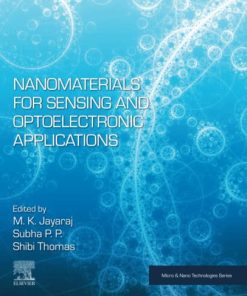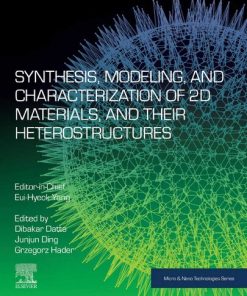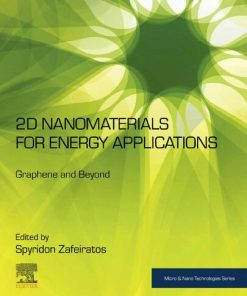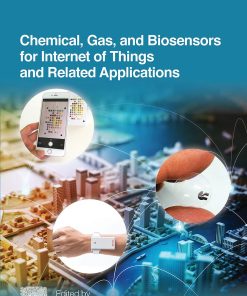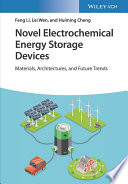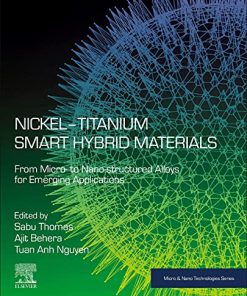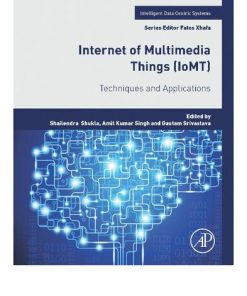(EBook PDF) Emerging 2D Materials and Devices for the Internet of Things Information Sensing and Energy Applications Micro and Nano Technologies 1st Edition by Li Tao, Deji Akinwande 012818387X 9780128183878 full chapters
$50.00 Original price was: $50.00.$25.00Current price is: $25.00.
(EBook PDF) Emerging 2D Materials and Devices for the Internet of Things Information Sensing and Energy Applications Micro and Nano Technologies 1st Edition by Li Tao, Deji Akinwande – Ebook PDF Instant Download/DeliveryISBN: 012818387X, 9780128183878
Full download Emerging 2D Materials and Devices for the Internet of Things Information Sensing and Energy Applications Micro and Nano Technologies 1st Edition after payment
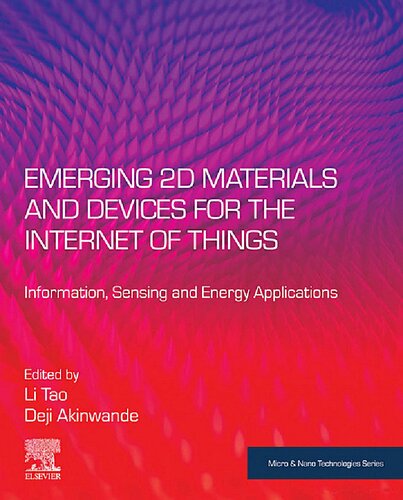
Product details:
ISBN-10 : 012818387X
ISBN-13 : 9780128183878
Author: Li Tao, Deji Akinwande
Emerging 2D Materials and Devices for the Internet of Things: Information, Sensing and Energy Applications summarizes state-of-the-art technologies in applying 2D layered materials, discusses energy and sensing device applications as essential infrastructure solutions, and explores designs that will make internet-of-things devices faster, more reliable and more accessible for the creation of mass-market products. The book focuses on information, energy and sensing applications, showing how different types of 2D materials are being used to create a new generation of products and devices that harness the capabilities of wireless technology in an eco-efficient, reliable way.
Emerging 2D Materials and Devices for the Internet of Things Information Sensing and Energy Applications Micro and Nano Technologies 1st Table of contents:
1 Two-dimensional materials-based nonvolatile resistive memories and radio frequency switches
1.1 Introduction to two-dimensional nonvolatile resistive memory
1.2 Two-dimensional materials preparation and memory device fabrication
1.2.1 Preparation and characterization of two-dimensional monolayers
1.2.2 Fabrication of memory devices
1.2.2.1 Crossbar
1.2.2.2 Litho-free and transfer-free
1.2.2.3 Exfoliation
1.3 Two-dimensional nonvolatile resistive memory
1.3.1 Nonvolatile resistive memory based on different device conditions
1.3.1.1 Crossbar device
1.3.1.2 Litho-free and transfer-free device (no polymer contamination)
1.3.1.3 Single crystalline device (no grain boundary)
1.3.1.4 Using different metal as electrodes
1.3.2 Memory performance
1.3.2.1 Reliability
1.3.2.2 Pulse operation
1.3.2.3 Flexibility
1.4 Switching mechanics
1.4.1 Factors influencing resistive switching
1.4.1.1 Temperature dependence
1.4.1.2 Device area dependence
1.4.1.3 Compliance current dependence
1.4.1.4 Voltage sweep rate and MoS2 layer number dependence
1.4.2 Possible switching mechanics based on ab initio simulation
1.5 MoS2 radio frequency switches
1.5.1 Introduction to radio frequency switch
1.5.2 Fabrication and measurement of MoS2 radio frequency switch
1.5.3 MoS2 radio frequency switch performance
1.6 Summary
Acknowledgment
References
2 Two-dimensional materials-based radio frequency wireless communication and sensing systems for Int
2.1 Introduction
2.2 Radio frequency performance of two-dimensional transistors
2.3 Frequency mixers and signal modulators based on two-dimensional transistors
2.4 Integrated wireless Internet-of-things sensors
2.5 Radio frequency energy harvesting using two-dimensional electronic devices
2.6 Conclusion
References
3 Graphene electronic tattoo sensors for point-of-care personal health monitoring and human–machin
3.1 Introduction
3.2 Theoretical background
3.2.1 Elastic membrane-skin conformability
3.2.2 Electrical model of skin-conformal and skin-nonconformal dry sensors
3.3 Fabrication of graphene electronic tattoo sensors
3.4 Applications of graphene electronic tattoo sensors and effects of the thickness on performance
3.4.1 Skin temperature sensing
3.4.2 Skin hydration sensing
3.4.3 Electrocardiography
3.4.4 Electroencephalography
3.4.5 Electromyography
3.4.6 Electrooculography
3.4.7 Human–machine interface
3.5 Conclusion
References
4 Transition metal dichalcogenides as ultrasensitive and high-resolution biosensing nodes
4.1 New opportunities for biosensing devices
4.2 Electronic biosensors made from transition metal dichalcogenides
4.3 Biosensors based on optical and optoelectronic properties of transition metal dichalcogenides
4.4 Biosensors based on structural properties of transition metal dichalcogenides
4.5 Final remarks
References
5 Nanophotonics and optoelectronics based on two-dimensional MoS2
5.1 MoS2-based nanoplasmonics
5.1.1 Exciton–plasmon interactions in MoS2
5.1.2 Plasmonic hot-electron injection
5.1.3 Surface plasmons in highly doped MoS2
5.1.4 Nanofabrication of plasmonic-MoS2 structures
5.2 MoS2-based optoelectronics
5.2.1 MoS2-based photodetectors
5.2.2 MoS2-based solar cells
5.2.3 MoS2-based light-emitting diodes
5.2.4 MoS2-optical cavity systems for enhanced light-emitting performance
5.3 Summary
References
6 Graphene-based anode materials for lithium-ion batteries
6.1 Introduction
6.2 Lithium-ion batteries and anode materials
6.2.1 Fundamentals of lithium-ion batteries
6.2.2 Challenges on anode materials
6.3 Graphene and graphene-based composites as anode materials
6.3.1 Graphene anodes
6.3.1.1 Porous graphene anodes
6.3.1.2 Doped graphene anodes
6.3.2 Graphene-based nanocomposite anodes
6.3.2.1 Graphene/insertion-type anodes
6.3.2.2 Graphene/alloy-type anodes
6.3.2.3 Graphene/conversion-type anodes
6.4 Conclusion and outlook
References
7 Two-dimensional materials as photoelectrodes in water reduction devices for energy applications
7.1 Basic mechanism of solar water splitting
7.2 Design principles of photoelectrochemical cells for water splitting
7.3 Two-dimensional materials as conducting channels
7.4 Two-dimensional materials as charge mediator/separator
7.5 Two-dimensional materials as cocatalysts
7.6 Two-dimensional materials as other roles
7.7 Summary and perspectives
References
8 Two-dimensional Xenes and their device concepts for future micro- and nanoelectronics and energy a
8.1 Introduction
8.2 First-generation Xenes
8.2.1 Silicene
8.2.2 Germanene
8.2.3 Stanene
8.2.4 Plumbene
8.3 Second-generation Xenes
8.3.1 Borophene
8.3.2 Gallenene
8.3.3 Phosphorene
8.3.4 Arsenene
8.3.5 Antimonene
8.3.6 Bismuthene
8.3.7 Selenene
8.3.8 Tellurene
8.4 Perspectives and conclusion
References
9 Piezoelectric one- to two-dimensional nanomaterials for vibration energy harvesting devices
9.1 Introduction
9.2 Preparation and characterization of piezoelectric 1–2D nanomaterials
9.2.1 BZT-BCT nanofilm
9.2.2 Piezoelectric nanofibers
9.3 Piezoelectric 1–2D nanomaterial for energy harvesting
9.3.1 Nanogenerator
9.3.2 Self-charging power cell
9.3.3 Strain sensor
9.3.4 Dye degradation
9.4 Conclusion
Acknowledgment
References
10 Nanocomposite materials for nano-electronic-based Internet of things sensors and energy device si
10.1 Introduction
10.2 Nanocomposite materials for chemical sensory devices and Internet of things
10.2.1 Composite materials based on carbon nanotube/graphene and functional building blocks
10.2.1.1 Organic polymer–functionalized carbon nanomaterials
10.2.1.2 Metal oxide–functionalized carbon nanomaterials
10.2.1.3 Metal-functionalized carbon nanomaterials
10.2.1.4 Interface between carbon nanomaterials and the functionalization layer
10.2.2 Nano-electronic-based sensory devices
10.2.2.1 Device configuration
10.2.2.2 Device performance: chemiresistor and field-effect transistor
10.2.3 Chemical sensors from single-walled carbon nanotube-based composites and their applications i
10.2.3.1 Single-walled carbon nanotube/PAni core/shell composites for chemical sensing
10.2.3.2 Breath analysis
10.2.4 Perspectives and challenges of nano-electronic sensors in Internet of things technology
10.3 Electronic sensing and signaling for sustainable energy devices
10.3.1 Principles and methodology of nano-electronic approach for chemical signaling
10.3.2 Application of electrical transportation spectroscopy for energy device investigations
10.3.2.1 New insights on various energy conversion reactions
10.3.2.2 Monitoring of anionic chemisorption and interfacial competition with reactive intermediates
10.3.2.3 Application in the bioelectrochemical system
10.3.3 Benefits and challenges of energy device signaling in Internet of things
References
11 Prospects and challenges in low-dimensional materials and devices for Internet of things
11.1 Flexible and wearable devices for Internet of things
11.1.1 Substrates
11.1.2 Two-dimensional materials as a functional layer
11.1.2.1 Graphene
11.1.2.2 Transition metal dichalcogenides
11.1.3 Progress and challenges
11.2 Human–machine interface devices for Internet of things
11.2.1 Internet of things and human–machine interface
11.2.2 A wearable sensor in human–machine interface system
11.2.3 Electronic skin
11.2.3.1 Pressure sensor for electronic skin
11.2.3.2 Human–machine interface enabled by triboelectric nanogenerator
11.2.3.3 Electric signal recordings for human–machine interface
11.2.3.4 Multifunctional human–machine interface sensors
11.2.4 Summary and prospective
11.3 Two-dimensional multifunctional device node for Internet of things
11.3.1 Sensor, modulator, and memory multifunction
11.3.2 Amplitude, frequency, and phase position hybrid modulation
11.3.3 Sensing, radio frequency, and energy collection simultaneously
11.3.4 Prospective and challenges
11.4 Sustainable energy devices for Internet of things
11.4.1 Fuel cell
11.4.2 Supercapacitors
11.4.3 Energy harvesting systems
11.4.3.1 Solar cells
11.4.3.2 Thermoelectric generators
11.4.4 Summary
11.5 5G/6G technology engaging with Internet of things
11.5.1 High bandwidth
11.5.2 Low-latency, real-time data communication
11.5.3 Artificial intelligence
11.5.4 Outlook
People also search for Emerging 2D Materials and Devices for the Internet of Things Information Sensing and Energy Applications Micro and Nano Technologies 1st:
emerging materials and technologies
emerging materials for future devices
emerging devices
emerging materials intelligence ecosystems propelled by machine learning
an emerging technology
Tags:
Emerging 2D,Materials,Devices,the Internet,Things,Information,Sensing,Energy Applications,Nano Technologies,Li Tao
You may also like…
Uncategorized
Engineering
Chemical, Gas, and Biosensors for Internet of Things and Related Applications Kohji Mitsubayashi
Uncategorized
Engineering
Performance and Security for the Internet of Things: Emerging Wireless Technologies Haya Shajaiah




